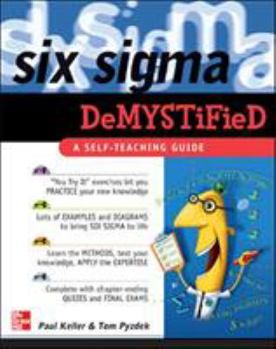Six SIGMA Demystified: A Self-Teaching Guide
Select Format
Select Condition 
Book Overview
Learning Six Sigma CAN be a painless process Six Sigma is among the most effective process methods used today--and it's also among the most baffling topics to those new to the subject. The good news... This description may be from another edition of this product.
Format:Paperback
Language:English
ISBN:0071445447
ISBN13:9780071445443
Release Date:December 2004
Publisher:McGraw-Hill Education
Length:450 Pages
Weight:1.90 lbs.
Dimensions:1.3" x 7.4" x 9.2"
Customer Reviews
3 ratings
Used This As a Handout for Students in My Class
Published by Thriftbooks.com User , 15 years ago
I handed out one of these to each student in my "6 Sigma in the EVMS Environment" course. Of the many books I studied on 6 Sigma this book had the best approach to defining and demonstrating the tools available for process improvement. It lists the tools in the front then covers each one including an example that gets you started thinking about your own examples.
Brown Belt for Now
Published by Thriftbooks.com User , 19 years ago
Six Sigma is a tool used to measure quality for the purpose of eliminating non-conformance or defects in a process or product as I see it. Data collection is very important for analysis. Thus, data collection systems designs are important to this end. The statistical representation of Six Sigma is really the best benchmark to quantify and evaluate process performance. This book ultimately must rely on that fact. I found this book's reasoning similar to that of trying to define Standard Deviation in words. Standard Deviation is a formula. I did find this book thought provoking and I liked the fact that such concepts as Six Sigma are still alive. Most companies fail because they bring Six Sigma in but then give up on it. In my area of the country I have spoken to so many people who no longer use it even though their companies say otherwise. If you want to learn more about Six Sigma this really is not a bad book.
A statistical approach to project management
Published by Thriftbooks.com User , 19 years ago
This book is part of the DeMYSTiFied series. These books are a little more sophisticated than the "For Dummies" or "Idiots" books. Of course they are sneaky with statements like "No fancy formulas" or "No staggering statistics" both statements that must have been written by rocket scientists. That is what this book is "Plain monstrous Formulas" and overwhelming statistics." But the truth is there is no other way to explain "Six Sigma." The book seems more geared towards Quality than projects but the same thinking process is there. Just as there is a TQM mystic and now PMI's PMBOK we have a Six Sigma culture with it own language that also usurps terms as green and blank belt. In the end they take what should be a strait forward mathematical problem and attempt to apply it to the unknown to come up with a working risk analysis. Using this method most projects will survive nicely on two to four sigmas. However this is one tool that I would what to know is at my disposal when tackling the next project. And this book does a good job of getting you off the ground.






